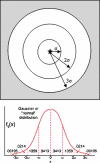A context-sensitive approach to anonymizing spatial surveillance data: impact on outbreak detection
- PMID: 16357353
- PMCID: PMC1447544
- DOI: 10.1197/jamia.M1920
A context-sensitive approach to anonymizing spatial surveillance data: impact on outbreak detection
Abstract
Objective: The use of spatially based methods and algorithms in epidemiology and surveillance presents privacy challenges for researchers and public health agencies. We describe a novel method for anonymizing individuals in public health data sets by transposing their spatial locations through a process informed by the underlying population density. Further, we measure the impact of the skew on detection of spatial clustering as measured by a spatial scanning statistic.
Design: Cases were emergency department (ED) visits for respiratory illness. Baseline ED visit data were injected with artificially created clusters ranging in magnitude, shape, and location. The geocoded locations were then transformed using a de-identification algorithm that accounts for the local underlying population density.
Measurements: A total of 12,600 separate weeks of case data with artificially created clusters were combined with control data and the impact on detection of spatial clustering identified by a spatial scan statistic was measured.
Results: The anonymization algorithm produced an expected skew of cases that resulted in high values of data set k-anonymity. De-identification that moves points an average distance of 0.25 km lowers the spatial cluster detection sensitivity by less than 4% and lowers the detection specificity less than 1%.
Conclusion: A population-density-based Gaussian spatial blurring markedly decreases the ability to identify individuals in a data set while only slightly decreasing the performance of a standardly used outbreak detection tool. These findings suggest new approaches to anonymizing data for spatial epidemiology and surveillance.
Figures






References
-
- Buckeridge DL, Burkom H, Campbell M, Hogan WR, Moore AW, Project B. Algorithms for rapid outbreak detection: a research synthesis. J Biomed Inform. 2005;38:99–113. - PubMed
-
- Sweeney L. k-Anonymity: A model for protecting privacy. Int J Uncertainty Fuzziness Knowledge-Based Syst. 2002;10:557–70.
Publication types
MeSH terms
Grants and funding
LinkOut - more resources
Full Text Sources

